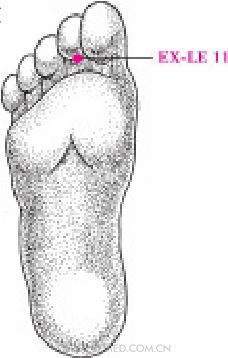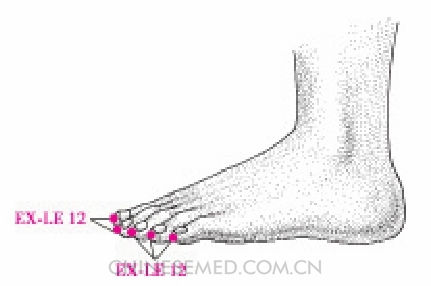- Zhǒu Jiān (EX-UE 1, 肘尖)
- Èr Bái (EX-UE 2, 二白)
- Zhōng Quán (EX-UE 3, 中泉)
- Zhōng Kuí (EX-UE 4, 中魁)
- Dà Gǔ Kōng (EX-UE 5, 大骨空)
- Xiǎo Gǔ Kōng (EX-UE 6, 小骨空)
- Yāo Tòng Diǎn (EX-UE 7, 腰痛点)
- Wài Láo Gōng (EX-UE 8, 外劳宫)
- Bā Xié (EX-UE 9, 八邪)
- Sì Fèng (EX-UE 10, 四缝)
- Shí Xuān (EX-UE 11, 十宣)
- Extra Points of the Lower Limbs
- Kuān Gǔ (EX-LE 1, 髋骨)
- Hè Dǐng (EX-LE 2, 鹤顶)
- Bǎi Chóng Wō (EX-LE 3, 百虫窝)
- Nèi Xī Yǎn (EX-LE 4, 内膝眼)
- Xī Yǎn (EX-LE 5, 膝眼)
- Dǎn Náng (EX-LE 6, 胆囊)
- Lán Wěi (EX-LE 7, 阑尾)
- Nèi Huái Jiān (EX-LE 8, 内踝尖)
- Wài Huái Jiān (EX-LE 9, 外踝尖)
- Bā Fēn⁝ (EX-LE 10, 八风)
- Dú Yīn (EX-LE 11, 独阴)
- Qì Duān (EX-LE 12, 气端)
Zhǒu Jiān (EX-UE 1, 肘尖)
Location. Behind the elbow on the tip of the olecranon process of the ulna (Pic. 3-118).
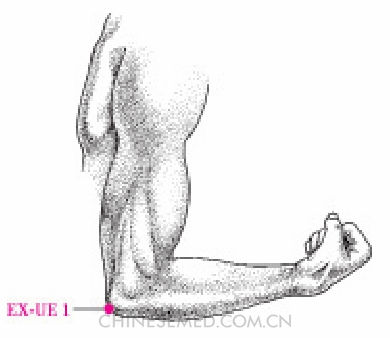
Location.method. With the elbow flexed 90°, the point is on the tip of the olecranon process of the ulna.
Actions. Disperse masses, dissolve phlegm, clear heat, and resolve toxins.
Indications. Scrofula, carbuncles, sores.
Manipulation. Acupuncture: Needle shallowly 0.1~0.3 cun to cause local soreness and distention. Moxibustion: Use 3~5 cones of cone moxibustion or 5~10 minutes with a moxa stick.
Èr Bái (EX-UE 2, 二白)
Location. On the fexor aspect of the forearm 4 cun above the transverse crease of the wrist on both sides of the tendon of fexor carpi radialis; two on each side (Pic. 3-119).
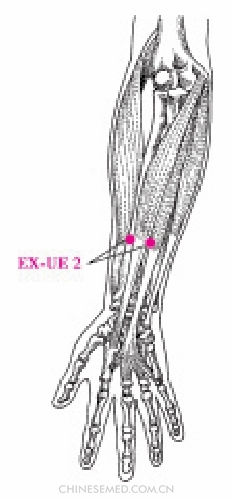
Location.method. With the arm extended and the palm turned upward, one point is found on each side of the tendon of fexor carpi radialis, at the junction of the upper 2/3 and lower 1/3 of the line connecting PC 3 (qūzé) and PC 7 (dà líng).
Actions. Regulate and harmonize qi and blood, lift anus, and resolve hemorrhoids.
Indications. Prolapsed anus, hemorrhoids.
Manipulation. Acupuncture: Needle perpendicularly 0.5~0.8 cun to cause local soreness and distention that radiates to the fngertips. Moxibustion: Use 3~5 cones of cone moxibustion or 5~10 minutes with a moxa stick.
Modern clinical observation and research. In a case series on hemorrhoids, èr bái (EX-UE 2) was needled perpendicularly 1 cun. Needles were retained for 30 minutes after the arrival of qi and manipulated every 10 minutes. All 49 patients improved.1
Zhōng Quán (EX-UE 3, 中泉)
Location. On the dorsal transverse wrist crease in the depression on the radial side of the extensor digitorum tendon (Pic. 3-120).

Location.method. With the arm extended and the palm facing upward, the point is at the midpoint of the line connecting LI 5 (yáng xī) and SJ 4 (yáng chí).
Actions. Move qi to relieve pain, relieve cough and panting.
Indications. Bronchitis, bronchial asthma; gastritis, enteritis.
Manipulation. Acupuncture: Needle perpendicularly 0.3~0.5 cun to cause local soreness and distention; numbness and electric sensations might radiate to fngertips and elbow. Moxibustion: Use 3~7 cones of cone moxibustion or 5~15 minutes with a moxa stick.
Zhōng Kuí (EX-UE 4, 中魁)
Location. The midpoint of the proximal interphalangeal joint of the dorsum of the middle fnger (Pic. 3-120).
Actions. Regulate qi and harmonize the center.
Indications. Digestive system disorders such as acute gastritis and cardiac obstruction.
Manipulation. Acupuncture: Needle perpendicularly 0.2 cun to cause local soreness and distention. Moxibustion: Use 2~3 cones or 5~10 minutes with a moxa stick.
Modern clinical observation and research. In a case series on hiccup, zhōn⁝ kuí (EX-UE 4) was needled perpendicularly 0.2~0.4 cun. De qi was obtained by lifting and thrusting; the needle was retained for 30 minutes. After one or two treatments, 40 cases of 42 recovered with no recurrence by the one-week follow-up.2
Dà Gǔ Kōng (EX-UE 5, 大骨空)
1 Pei SD. Treatment of 49 cases of hemorrhoid pain by puncturing èr bái (EX-UE 2) 针刺二白穴治疗痔痛49例. Journal of Sichuan Traditional Chinese Medicine. 2003; 21(9): 78.
2 Huang JR. Treatment of 42 cases of hiccup by puncturing zhōn⁝ kuí (EX-UE 4) 针刺中魁穴治疗呃逆42例. Journal of External Therapy of Traditional Chinese Medicine. 2003; 12(4): 46-7.
Location. Midpoint of the interphalangeal joint of the dorsum of the thumb (Pic. 3-121).
Actions. Remove nebula to improve vision.
Indications. Conjunctivitis, keratitis, cataract, nasal hemorrhage; acute gastroenteritis.
Manipulation. Acupuncture: Prick point. Moxibustion: Use 3~5 cones of cone moxibustion or 5~10 minutes with a moxa stick.
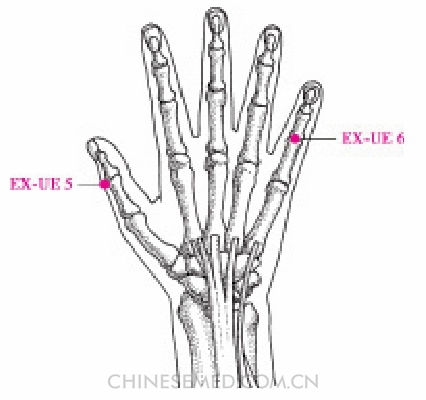
Xiǎo Gǔ Kōng (EX-UE 6, 小骨空)
Location. Midpoint of the proximal interphalangeal joint of the dorsum of the little fnger (Pic. 3-121).
Actions. Improve vision and relieve pain.
Indications. Eye disorders, pharyngitis, metacarpophalangeal joint pain.
Manipulation. Acupuncture: No acupuncture is done on this point. Moxibustion: Use 3~5 cones of cone moxibustion or 5~10 minutes with a moxa stick.
Yāo Tòng Diǎn (EX-UE 7, 腰痛点)
Location. The dorsum of the hand between the second and third metacarpal bones and the fourth and fifth metacarpal bones at the midpoint of the distal transverse crease of the dorsum of the wrist and metacarpophalangeal joints; two points on each side (Pic. 3-122).
Actions. Relax sinews, quicken collaterals, dissolve stasis, and relieve pain.
Indication. Acute lumbar sprain.
Manipulation. Acupuncture: Needle perpendicularly 0.3~0.5 cun to cause local soreness and distention that radiates to the tip of the fngers.
Wài Láo Gōng (EX-UE 8, 外劳宫)
Location. The dorsum of the hand between the second and third metacarpals, 0.5 cun posterior to the metacarpophalangeal joint just opposite PC 8 (láo gōng) on the palm (Pic. 3-123).
Actions. Dredge channels and activate collaterals, dispel wind, and relieve pain.
Indications. Stiff neck, swelling and pain of arms, neonatal tetanus.
Manipulation. Acupuncture: Needle perpendicularly 0.3~0.5 cun to cause local soreness and distention; numbness and electric sensations can radiate to the fingertips. Moxibustion: Use 3~5 cones of cone moxibustion or 5~10 minutes with a moxa stick.

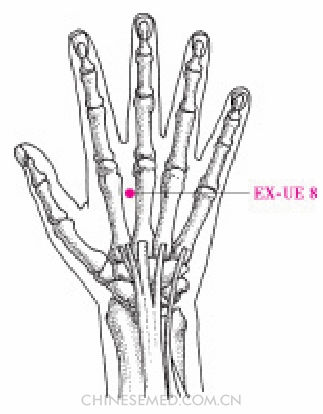
Bā Xié (EX-UE 9, 八邪)
Location. The dorsum of the hand between the first and fifth fngers, proximal to the web between the fve fngers at the junction of the red and white skin; eight points, four on each hand (Pic. 3-124).
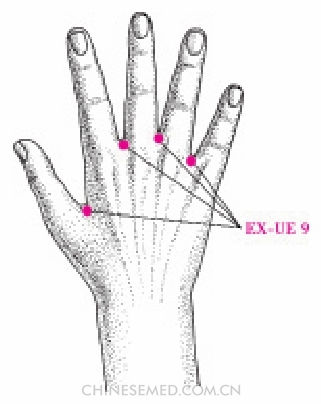
Actions. Dispel pathogens, unblock collaterals, clear heat, and resolve toxins.
Indications. Disorders of the fnger joints, numbness of the fngers; headache; painful throat; venomous snake bite.
Manipulation. Acupuncture: 1. Needle obliquely 0.5~0.8 cun upward causing local soreness and distention; numbness might radiate to the fingertips. 2. Bleed with a three-edged needle. Moxibustion: Use 3~5 cones of cone moxibustion or 5~10 minutes with a moxa stick.
Sì Fèng (EX-UE 10, 四缝)
Location. On the palmar surface of fingers at the midpoint of the transverse crease of the proximal interphalangeal joints; four points on each hand (Pic. 3-125).
Actions. Promote digestion, remove accumulation, dispel phlegm, and remove stagnation.
Indications. Pediatric diseases such as whooping cough, infantile malnutrition, and intestinal ascariasis.
Manipulation. Acupuncture: Prick the point 0.1~0.2 cun and extrude a small amount of yellowish-white, transparent mucus and blood; there should be local soreness and distention. Do not use moxibustion.
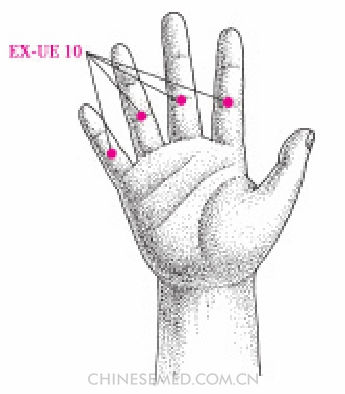

Shí Xuān (EX-UE 11, 十宣)
Location. On the tips of the ten fngers, 0.1 cun distal to the nail; ten points in total (Pic. 3-126).
Actions. Discharge heat to save from collapse.
Indications. Unconsciousness, shock; acute pharyngitis, acute gastroenteritis, acute tonsillitis; numbness of the fngers.
Manipulation. Acupuncture: 1. Needle perpendicularly 0.1~0.2 cun to cause local soreness and distention. 2. Bleed with a three-edged needle. Moxibustion: Use a moxa stick for 5~10 minutes.
Extra Points of the Lower Limbs
Kuān Gǔ (EX-LE 1, 髋骨)
Location. On the anterior region of both thighs 1.5 cun lateral to ST 34 (liáng qiū); 2 points on each side (Pic. 3-127).
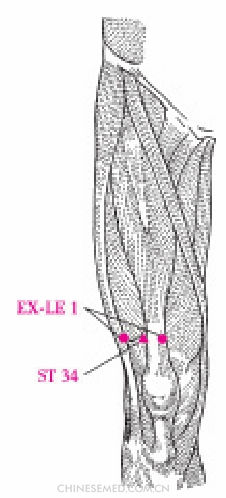
Actions. Dispel dampness, clear heat, and ease joint movement.
Indications. Arthritis.
Manipulation. Acupuncture: Needle perpendicularly 0.5~1.0 cun to cause local soreness and distention that radiates to the knee. Moxibustion: Use 3~5 cones of cone moxibustion or 5~15 minutes with a moxa stick.
Hè Dǐng (EX-LE 2, 鹤顶)
Location. Above the knee in the depression at the midpoint of the superior border of the patella (Pic. 3-128).

Actions. Ease joint movement.
Indications. Knee pain, weakness of leg and foot, paralysis.
Manipulation. Acupuncture: Needle perpendicularly 0.5~0.8 cun to cause local soreness and distention. Moxibustion: Use 3~7 cones of cone moxibustion, or use warming needle moxibustion for 20 minutes, or 5~10 minutes with a moxa stick.
Bǎi Chóng Wō (EX-LE 3, 百虫窝)
Location. On the medial aspect of the thigh 3 cun proximal to the superior border of the patella (Pic. 3-128).
Location.method. With the knee flexed, the point is 1 cun superior to SP 10 (xuè hăi).
Actions. Invigorate blood and dispel wind, expel worms and eliminate accumulation.
Indications. Urticaria, rubella, itching, eczema; ascariasis.
Manipulation. Acupuncture: Needle perpendicularly 0.8~1.2 cun to cause local soreness and distention that sometimes radiates to the hip. Moxibustion: Use 3~5 cones of cone moxibustion, or use warming needle moxibustion for 20 minutes, or 5~10 minutes with a moxa stick.
Nèi Xī Yǎn (EX-LE 4, 内膝眼)
1 Ohlsen BA. Acupuncture and a gluten-free diet relieve urticaria and eczema in a case of undiagnosed dermatitis herpetiformis and atypical or extraintestinal celiac disease: A case report. J Chiropr Med. 2011; 10(4): 294-300.
Location. On the knee in the middle of the depression medial to the patellar ligament (Pic. 3-128).
Actions. Eliminate dampness, quicken collaterals, and ease joint movement.
Indications. Arthritis, chondromalacia patella.
Manipulation. Acupuncture: 1. With the patient’s knees flexed, needle obliquely 0.5~1.0 cun from the anteromedial to the posterolateral aspect. 2. Penetrate toward ST 35 (dú bí) to cause local soreness and distention that radiates to the entire knee joint or downward. The patient should not extend the knee during retention to avoid breaking the needle. Moxibustion: Use 3~5 cones of cone moxibustion or use warming needle moxibustion for 20 minutes, or 5~15 minutes with a moxa stick.
Xī Yǎn (EX-LE 5, 膝眼)
It is another name of ST 35 (dú bí, 犊鼻). So see ST 35.
Dǎn Náng (EX-LE 6, 胆囊)
Location. On the lateral aspect of the lower leg, 2 cun directly below the head of the fbula (Pic. 3-129).
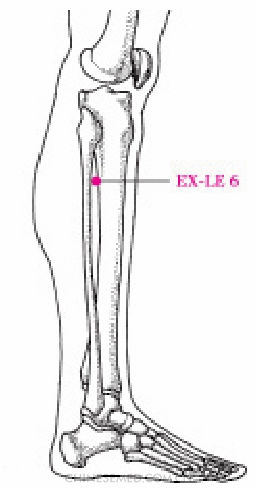
Location.method. With the patient sitting or lying on the side, the point is 2 cun directly below GB 34 (yáng líng quán). Palpate to fnd the spot of maximum tenderness.
Actions. Promote gallbladder function and dredge the bowels.
Indications. Acute and chronic appendicitis, cholelithiasis, biliary angina; atrophy or paralysis of the lower limbs.
Manipulation. Acupuncture: Needle perpendicularly 1.0~1.5 cun to cause local soreness and distention that might radiate downward. Moxibustion: Use 5~9 cones of cone moxibustion, or use warming needle moxibustion for 20 minutes, or 10~20 minutes with a moxa stick.
Lán Wěi (EX-LE 7, 阑尾)
Location. On the lateral aspect of the lower leg, 5 cun below the depression lateral to the patellar ligament and one fnger-breadth lateral to the anterior crest of the tibia (Pic. 3-130).
Location.method. With the patient sitting or supine with the knee flexed, the point is 1 cun superior to ST 37 (shàng jù xū). It is the spot of maximum tenderness upon palpation.
Actions. Clear heat, resolve pathogens, and dredge bowel qi.
Indications. Acute or chronic appendicitis; dyspepsia; atrophy or paralysis of the lower limbs.
Manipulation. Acupuncture: Needle perpendicularly 0.5~1.0 cun to cause local soreness and distention that radiates to the dorsum of the foot. Moxibustion: Use 5~9 cones of cone moxibustion, or use warming needle moxibustion for 20 minutes, or 10~20 minutes with a moxa stick.
Nèi Huái Jiān (EX-LE 8, 内踝尖)
Location. The medial aspect of the foot at the prominence of the medial malleolus (Pic. 3-131).
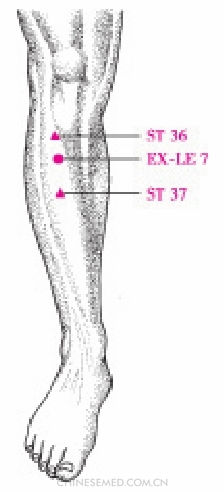
Actions. Relax sinews and quicken collaterals.
Indications. Toothache, gastrocnemius spasms.
Manipulation. Acupuncture: Bleed with a three-edged needle. Moxibustion: Use 3~5 cones of cone moxibustion or 5~10 minutes with a moxa stick.
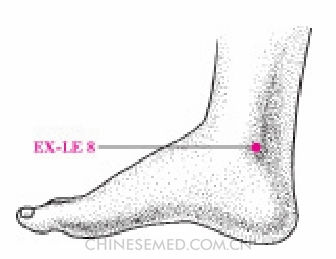
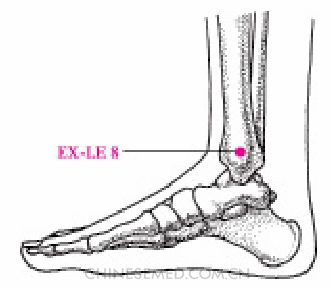
Wài Huái Jiān (EX-LE 9, 外踝尖)
Location. At the lateral aspect of the foot on the prominence of the lateral malleolus (Pic. 3-132).
Actions. Relax sinews and quicken collaterals.
Indications. Toothache, gastrocnemius spasms.
Manipulation. Acupuncture: Bleed with a three-edged needle. Moxibustion: Use 3~5 cones of cone moxibustion or 5~10 minutes with a moxa stick.
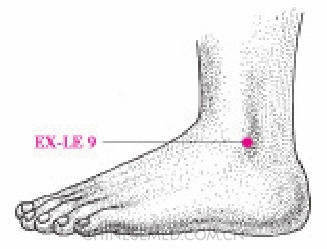
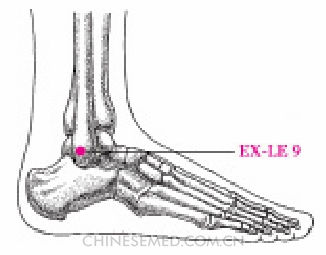
Bā Fēn⁝ (EX-LE 10, 八风)
Location. On the dorsum of the foot between the first and fifth toes at the junction of the red and white skin posterior to the margin of the web; 4 points on each foot, 8 in total (Pic. 3-133).
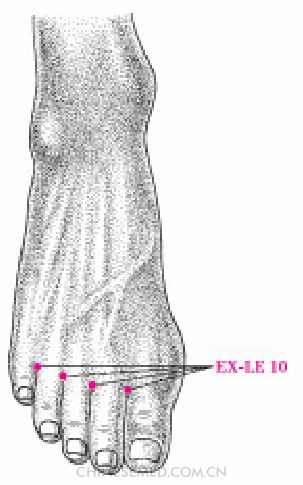
Actions. Dispel wind and unblock collaterals, clear heat and resolve toxins.
Indications. Swelling and pain in the dorsum of the foot; toe pain; venomous snake bite; beriberi.
Manipulation. Acupuncture: 1. Needle obliquely 0.5~0.8 cun to cause local soreness and distention that radiates to the back of the foot or the tip of the toe. 2. Bleed with a three-edged needle. Moxibustion: Use 3~5 cones of cone moxibustion, or use warming needle moxibustion for 20 minutes, or 5~10 minutes with a moxa stick.
Dú Yīn (EX-LE 11, 独阴)
Location. On the sole of the foot, at the midpoint of the plantar surface of the distal interphalangeal joint of the second toe (Pic. 3-134).
Actions. Regulate chong mai and ren mai.
Indications. Angina pectoris, irregular menstruation.
1 Bao T, Zhang R, Badros A, Lao L. Acupuncture treatment for bortezomib-induced peripheral neuropathy: a case report. Pain Res Treat. 2011; 2011. Available from http: //www.hindawi.com/journals/prt/2011/920807/abs/.
Manipulation. Acupuncture: Needle perpendicularly 0.1~0.2 cun to cause local soreness and distention. Moxibustion: Use 3~5 cones of cone moxibustion or 5~10 minutes with a moxa stick.
Qì Duān (EX-LE 12, 气端)
Location. At the center of the tip of each of the ten toes 0.1 cun distal to the nails; ten points in total (Pic. 3-135).
Actions. Unblock collaterals and open the orifices.
Indications. Cerebrovascular accident; numb toe.
Manipulation. Acupuncture: 1. Needle perpendicularly 0.1~0.2 cun, to cause local soreness and distention. 2. Bleed with a three-edged needle. Moxibustion: Use 3~5 cones of cone moxibustion or 5~10 minutes with a moxa stick.
